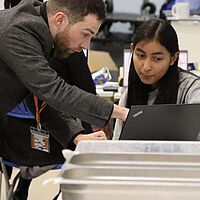Now you've probably heard the benefits of the standing desk, and maybe you've heard that sitting is our generation's version of smoking; it's really bad for us over long periods of time, but we don't really realise it (and office-based jobs are only increasing in number). But the question remains: could widespread standing desks cure our obsession with sitting? Well, we explore both the pros and cons to give you a better idea...
Sitting is slowly killing us
The average person sits for around 9.3 hours a day. At a 2013 TED conference in California, business writer Nilofer Merchant explained that this average is silently killing us. Alongside an average 7.7 hours of sleeping, that leaves people with 7 hours per day of not sitting. That might sound like a lot, but it really isn't in comparison to all of the rest (17 hours!) you're giving your body. Merchant claimed that this 'sedentary lifestyle' of ours contributes 10% to the risk of breast and colon cancer; 7% towards type 2 diabetes, and 6% to the risk of heart disease.
The Whitehall II study, conducted by the University of Exeter, contradicts previously cited correlations between sitting, and, well, death. They suggest that lack of movement in general is more damaging to our mortality risks, not just sitting: "previously reported relationships between sitting time and health outcomes may be due in part to low total daily energy expenditure." Though, the study does suggest that inactivity can cause a 9% increase in mortality risk.
Either way, seated workers are putting themselves at risk by not engaging in enough physical activity, and we need a solution. But is standing the answer?

What are the benefits of standing desks?
There is very little research into the direct health benefits that standing desks can provide, so most of the evidence we present here is anecdotal. The first benefit is that you're not sitting. As you're not sitting, and engaging more of your muscles, your circulation should improve, therefore improving your energy levels.
Steve Mullis, self-professed 'Stander', suggests that communication with colleagues also improves whilst standing, as he was more visible and found interacting with peers a lot easier.
Mullis explains that you'll strengthen your posture and core muscles from remaining upright. Furthermore, in contrast to sitting, he found that he was more alert and ready for action, as he didn't have to waste time switching from sedentary to active (i.e. getting up from his chair).
What about the disadvantages of standing all day?
Well, there are quite a lot actually. Your favourite cliché, "everything in moderation," even applies to standing. We are not built to stand in the same spot all day, nor sit, nor anything really.
Firstly, the visibility that Mullis mentioned as an advantage works both ways; everyone can see what you're doing, be it staring into space or fishing out a bogey.
More importantly, standing puts a lot of pressure on your body, and it hurts! 'Standers' have reported: back, leg, knee and feet pain... and it isn't just a matter of getting used to. Not to mention the fact that you're distracted by the discomfort that standing can cause, which works counter-intuitively (read more
here).You're also more likely to get varicose veins due to the pressure you put on your circulatory system, amongst other health problems.
So, what's the solution?
 Look how happy you could be!
Look how happy you could be!
Essentially, too much of anything is bad for you, so whether you stand all day or sit all day, remaining motionless is the catalyst. Instead, we should make conscious steps towards being more active during the day, rather than expecting a bi-weekly gym session to solve our problems across the board. Below are some suggested solutions:
- The aforementioned TED speaker, Nilofer Merchant, explains that her solution is 'walk-and-talk meetings'. Doing so, she racks up around 20-30 miles of walking per week. Plus, if it's nice weather, you can get outdoors and stay active, which will in turn boost your productivity and creativity.
- If your days aren't usually filled with meetings, you could try out a sit-stand desk, with adjustable desk height and a stool/chair for when you get tired.
- Researchers at the University of Chester have concluded that office workers should aim for an accumulation of 2 hours per day of standing and light activity (e.g. walking). This total time should then be progressively increased to 4 hours per day. "To achieve this, seated-based work should be regularly broken up with standing-based work, the use of sit-stand desks, or the taking of short active standing breaks."
- Even just making small changes to your daily habits, such as: going for a walk at lunchtime to break up the constant sitting, or walking to work (or a portion of the way) instead of using public transport or driving.
- If you can work out the logistics, sitting on the floor (with a cushion!) is an effective way to position yourself, because it's a lot harder for your body each time you need to get up. That might sound annoying, but the more exercise you can implement into your working day, the better. Need more convincing? They do it in Okinawa, Japan.
If you have any more suggestions for leading a healthy and active life whilst working in an office, do let us know by tweeting us:
@thegrbteam
 Look how happy you could be!
Essentially, too much of anything is bad for you, so whether you stand all day or sit all day, remaining motionless is the catalyst. Instead, we should make conscious steps towards being more active during the day, rather than expecting a bi-weekly gym session to solve our problems across the board. Below are some suggested solutions:
Look how happy you could be!
Essentially, too much of anything is bad for you, so whether you stand all day or sit all day, remaining motionless is the catalyst. Instead, we should make conscious steps towards being more active during the day, rather than expecting a bi-weekly gym session to solve our problems across the board. Below are some suggested solutions:




